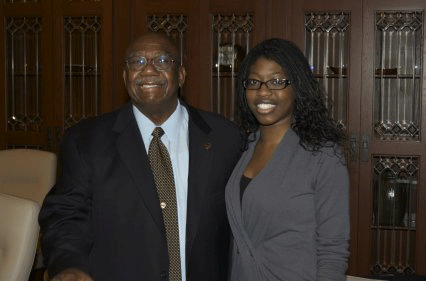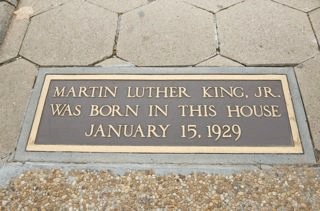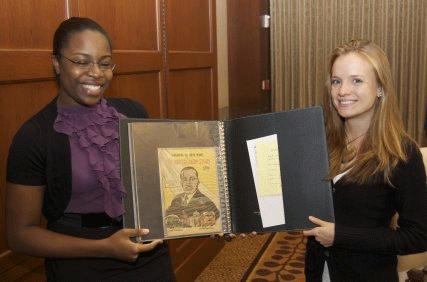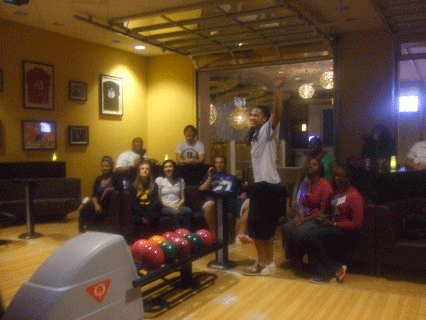Atlanta was the birthplace of Martin Luther King Jr., so much of our time today was spent learning about King, both as a man and as a leader. We began with a trip to the Kng Center, where we explored the exhibits in the Visitor Center and in Freedom Hall. Both Martin and Coretta Scott King are buried there, so we sat for a bit by their tombs and the eternal flame that burns nearby. A few blocks away is King’s birthhome – a lovely two story Queen Anne style home in Sweet Auburn, a historic African American community.
There we saw, among other things, the room where King was born and the second story window he is said to have jumped from (on more than one occasion,) with a towel wrapped around his neck, dressed as Superman. We were also quite taken by the stories of the King family’s dinner time, during which each child was required to report on one current event and recite one new Bible verse!
For lunch we headed to Cafe 458. This is no ordinary restaurant: a dining hall for the homeless six days a week, on Sunday it opens as a sit-down restaurant for the general public. Serviced by volunteers and stocked by donations, all of its profits (tips included) go to the homeless. It felt like an appropriate way to end our tour of King’s Atlanta.
Back at our hotel, we prepared for our visit with Charles Person. Mr. Person was only 18 when he made the courageous decision to become one of the first CORE Freedom Riders, and he was attacked by a Klan mob as he attempted to enter the white waiting area in the Birmingham bus station. He described his experience, shared artifacts and photos, and answered our questions.

Mr.Person was generous with his time, spending hours with us; we felt honored to be able to spend this time with him and his charming wife.
After dinner we all met in the rec room of the hotel. We bowled, played pool and shuffleboard, and listened to a CD compilation of each student’s (and faculty member’s!) favorite songs.
Student Responses:
Georgia: Today was about two men whose struggles allowed me to have dreams and have those dreams come to fruition, Dr. Martin Luther King and Freedom Rider Charles Person. We went to the King Center and toured his birth home where he lived till he was twelve years old. What touched me most about revisiting Dr. King was seeing the things that shaped him to be the remarkable man that he was, the man that shaped America to not see race but to see a person’s character. Martin Luther King’s childhood propelled him to be an instrument and a catalyst for change. His father at a young age taught him about racial injustices that happened to him, such as when a police officer racially profilied him and called him boy, ever though he was a grown man, college educated and a reverend. King’s family structure, education, church and even his neighborhood allowed him to be the man that he was. I am glad that the National Parks System made his neighborhood a national landmark. Growing up in this neighborhood, King saw the dichotomy between the rich and the poor. He lived in between the low and middle income families. The fact that the government saw this as a metaphor for his life is remarkable to me. They saw him as a man who corrected disparities between people. This form of commemoration I can appreciate because it emphasizes what made the man. I also appreciated meeting another extraordinary man, Freedom Rider Charles Person. I asked him this particular question: Our mini-term is about Public History (the commemoration of these events;) are you satisfied with how the events you participated in have been presented? His answer was no, textbooks and museums cannot convey the feelings and emotions of the movement. I agree with that assertion, the only way to really understand the movement is to hear from the people who lived it. Meeting Charles Person has inspired me to be a catalyst for, I will try to live up to all that he and the countless of others fought so hard to achieve.
Peter: Today we met with Charlest Person, the youngest Freedom Rider that took part in the bus rides from Washington DC to various points in the South. This was the first time we got to speak with someone who was involved in the movement. This made the experience more real for me. You can read all the books you want to, you can see all the films and photos that your mind will let you, but nothing can compare to actually sitting and talking with history. Charles Person gave us his perspective on what happened during the Freedom Rides and it was spectacular. I was enthralled in what he was telling us, and I was fortunate to be able to ask him a question. My question dealt with the transition from the traditional Civil Rights Movement to the Black Power Movement and it was cool to hear what he had to say about it. Mr. Person told me that it was Mississippi that fueled the Black Power movement. He explained to me that prior to going to Mississippi, Stokely Carmichael was nonviolent and a member of SNCC but when he saw how bad the situation was in Mississippi, he felt that nonviolence wouldn’t work anymore and switched his philosophical stance. I had never heard that explanation before. History books offer that it was Carmichael, who was the philosophical messiah of the Black Power Movement, but these books never explain why and getting this perspective from Charles Person was amazing. Speaking with him really got me excited to talk with some of the other people that we are going to meet on this trip. What an experience!
Marissa: Mr. Person passed around an original copy of the itinerary of the Freedom Rides that he participated in. As I sit here writing this entry, I glance over at my printed itinerary for this miniterm and can’t help but feel a connection. Something so simple as a piece of paper created so many emotions for me, making the Freedom Rides a reality by feeling a part of the past. “That was it,” I thought. “This was where Mr. Person and the other students (my age!) were set to travel.” Sure they had been prepared to face discrimination, hatred, and even violence during the trip, but they had no idea how angry the mobs would be. Studying the Freedom Riders’ itinerary, I looked at each city they were to stop in along the way and was filled with excitement realizing that we too were stopping in a lot of the same cities. I quickly remembered though that we, also an interracial group, weren’t going to be met by people wanting to take our lives simply for sitting on a bus or using the “wrong” bathroom. I looked up at Mr. Person and smiled. This man helped to make our trip a reality. Without the bravery and courage he portrayed during the Freedom Rides, who knows where the South would be today.
Aaron: Today we were in Atlanta and had the opportunity to tour the childhood home of Dr. Martin Luther King Jr. Just seeing this house in person, even from a distance, left more of an impression on me than any picture in a museum ever could. Just being on the front steps brought chills to my spine because yes, this is where King grew up as a child. Normally I’m not one to become overly excited about being somewhere touristy like this, but this was different. Setting foot in this house was literally like walking into a time machine and traveling back into the 1930’s. The furniture, the technology, the layout, the rules of the house, it really opened my eyes up to what it was like for Dr. King and his siblings to grow up and how differently we live today. I always hear stories from my grandparents about how life was during this time period but hearing similar stories about King really touched home.
Seeing this house and listening to stories about Dr. King growing up, humanized Dr. King in my mind. Reading books, watching film, listening to people speak about him had caused me to develop this God-like persona of him. It gave me this feeling that I could never ever have a hundredth of an impact on this society that he had -that he had a persona that is unattainable by the common citizen. But viewing the house led me to understand that this not the case. Dr. King grew up just like any other kid. He played and loved sports, hated chores, picked on his sister; he got himself into trouble and tried to find any and every existing shortcut available to limit the amount of work necessary for him to please his parents. I would never have learned this had I not visited Atlanta and made it to this home. This house is a symbol of Dr. King’s humble beginning and the basis of his effort and hard work that brought him to the places that he was able to go, thus showing me, and anyone who visits the home that with hard work, patience and perserverence, great things can be achieved.






